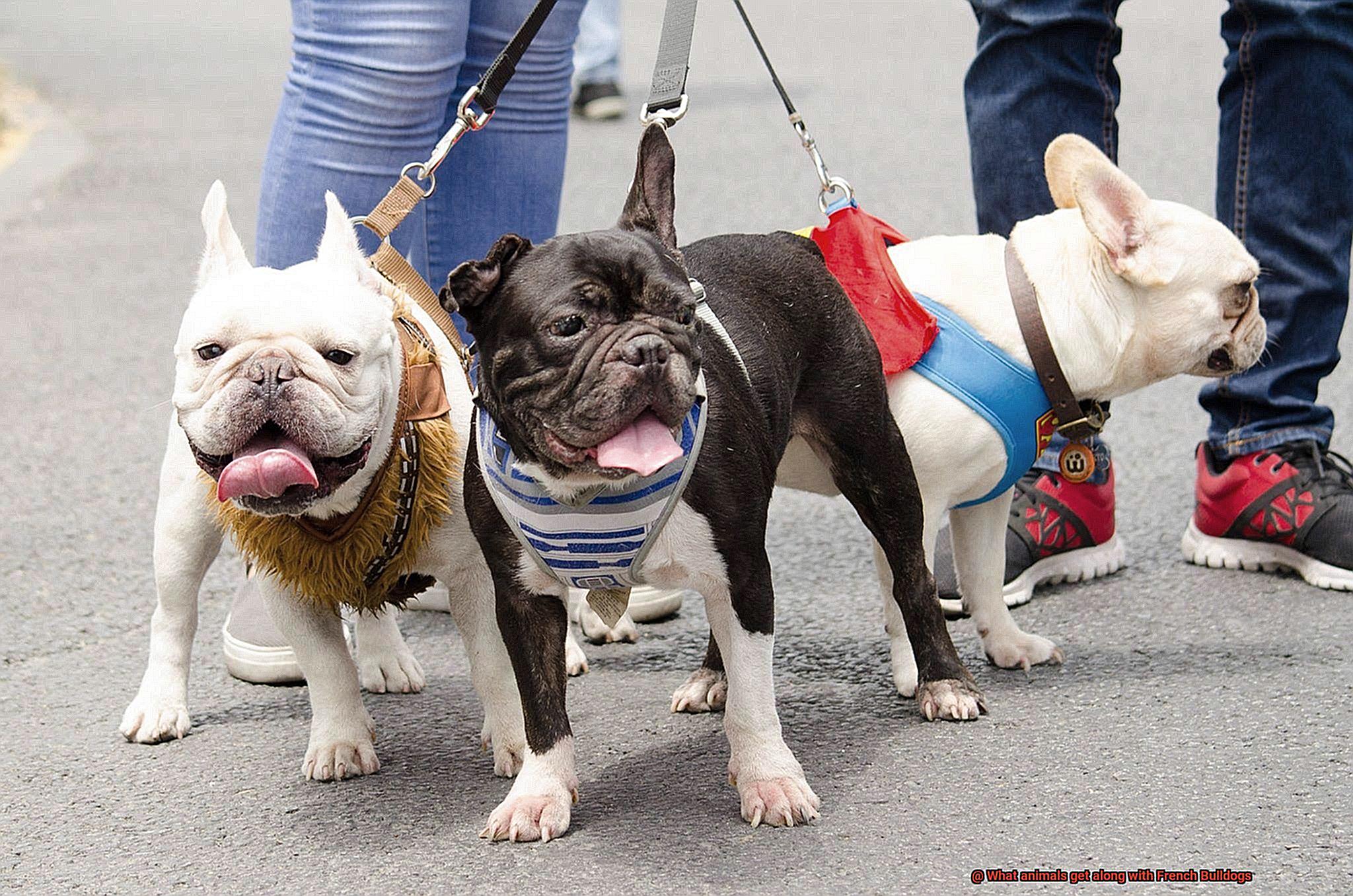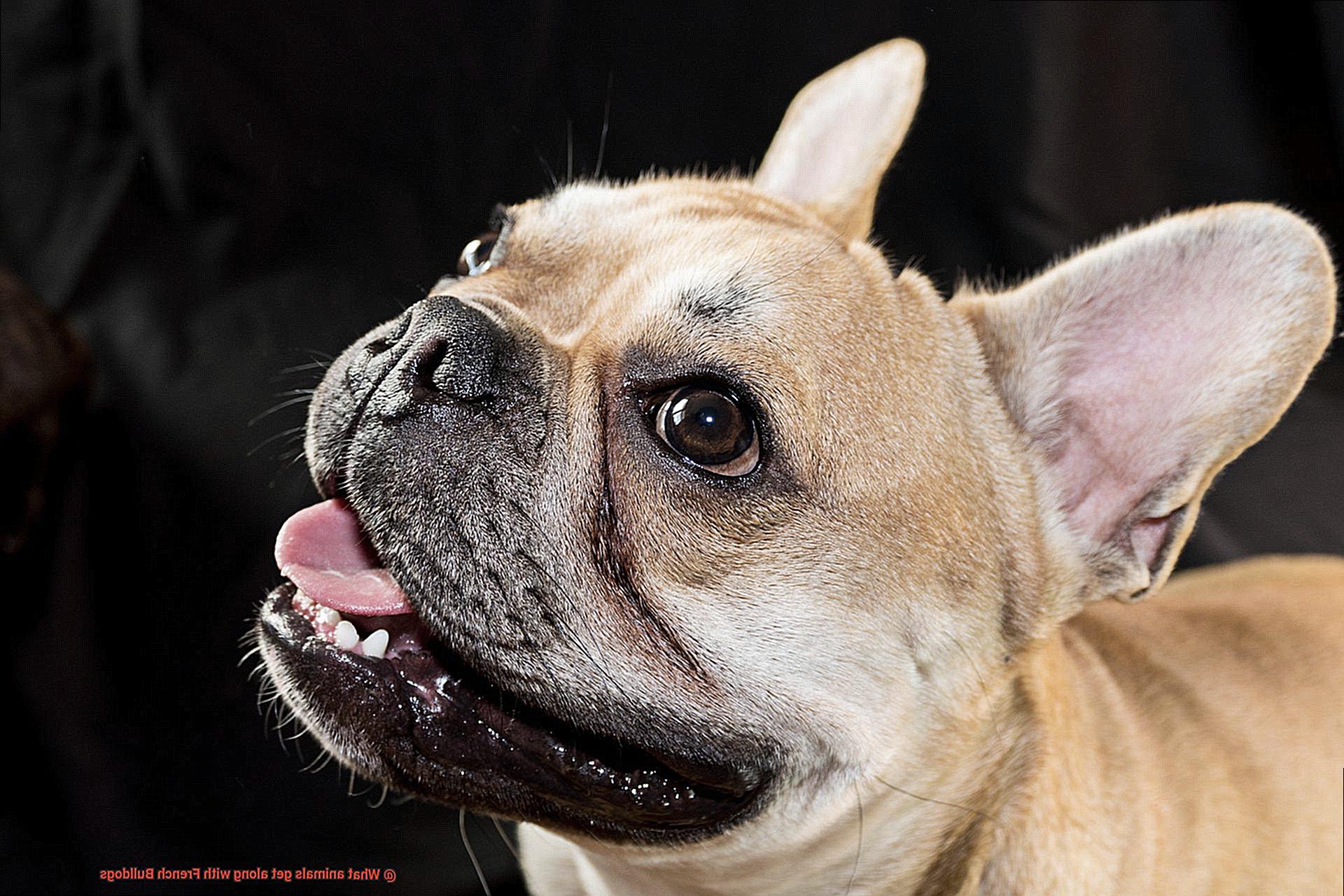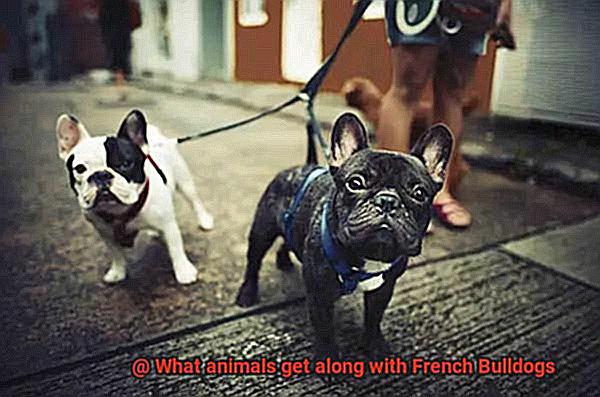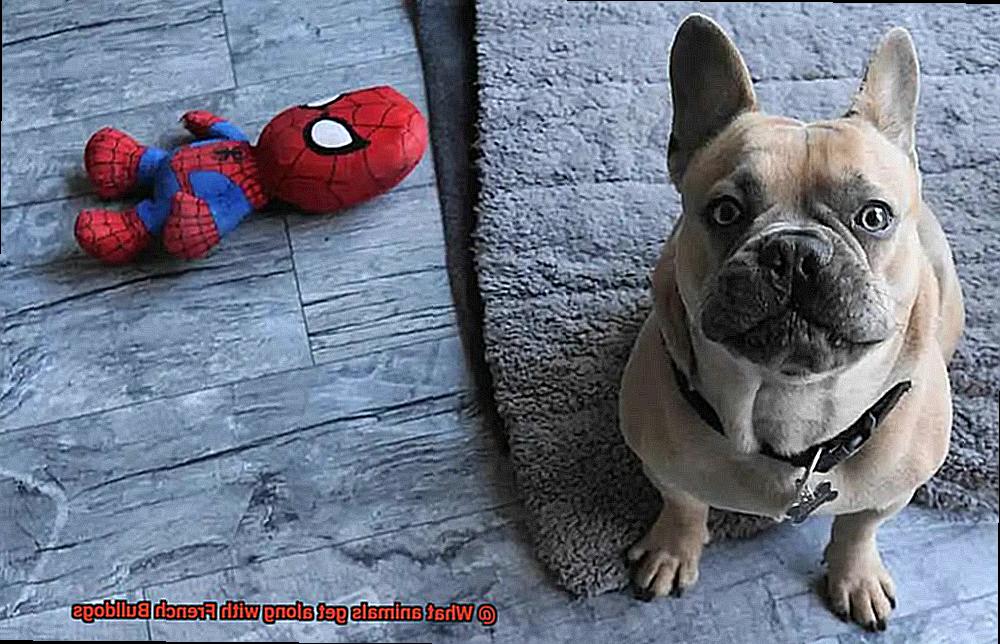What animals get along with French Bulldogs?
Step into the enchanting world of French Bulldogs and their extraordinary ability to form bonds with a wide range of animal companions.
These pint-sized bundles of joy are not only adorable but also possess an innate charm that can melt even the coldest of hearts. As you embark on your journey to find the perfect furry addition to your family, it’s crucial to consider which animals will harmonize effortlessly with these lovable little pups.
So, let’s delve into this captivating realm of French Bulldog camaraderie and discover which animals make the best comrades for these delightful dogs.
Understanding the Temperament of French Bulldogs
Contents
- 1 Understanding the Temperament of French Bulldogs
- 2 Getting Along With Other Dogs
- 3 Introducing French Bulldogs to Cats
- 4 Coexisting With Small Pets
- 5 Interacting With Birds Safely
- 6 Living Harmoniously With Livestock
- 7 Socializing and Supervising Interactions
- 8 Tips for Successful Introductions
- 9 Conclusion
In this article, we’ll delve deeper into the temperament of French Bulldogs and explore the factors to consider when determining their compatibility with other animals.

Affectionate and Sociable Nature:
French Bulldogs are known for their love of human companionship. They thrive on attention and are extremely affectionate towards their owners. This means that they are likely to get along well with animals that also enjoy human interaction, such as cats and certain small mammals.
Adaptability and Easygoing Nature:
French Bulldogs are adaptable and easygoing. They tend to be tolerant of different situations and can adjust well to new environments. This makes them more likely to get along with animals that have similar temperaments, such as other easygoing dog breeds or calm and gentle cats.
Prey Drive:
It’s essential to consider the prey drive of your French Bulldog when determining compatibility with smaller animals like birds or rodents. Some French Bulldogs may have a higher prey drive, which can make them less compatible with these types of animals. It’s crucial to evaluate your French Bulldog’s personality traits and carefully introduce them to smaller animals if necessary.
Socialization History:
Proper socialization from a young age greatly influences a French Bulldog’s ability to get along with other animals. If they have positive experiences and interactions with different animals during their socialization period, they are more likely to be accepting and friendly towards other animals in adulthood.
Introducing New Animals:
When introducing a new animal to your French Bulldog, take it slow and provide supervised conditions. Gradually increase the time they spend together and use positive reinforcement to build a strong foundation for a harmonious relationship. Remember, each animal is unique, so closely monitor their interactions and ensure a safe environment for everyone involved.
Getting Along With Other Dogs
Getting Along With Other Dogs: A French Bulldog’s Guide to New Friends
Introducing your French Bulldog to another dog can be an exciting and rewarding experience. These friendly and sociable dogs are generally well-suited for getting along with other canines. However, it is crucial to follow the proper steps to ensure a positive and stress-free interaction. As an expert in dog behavior, I have compiled a guide to help you introduce your French Bulldog to another dog and promote a harmonious relationship.
Step 1: Choose a Neutral Territory
When introducing two dogs, it is essential to select a neutral territory where neither dog feels territorial. This could be a park or an open space that is unfamiliar to both dogs. By starting in a neutral environment, you reduce the chances of any territorial behavior or aggression.
Step 2: Leashed Introductions
Begin the introduction with both dogs on leashes. Allow them to sniff and observe each other from a safe distance. Look for signs of calm and relaxed body language, such as loose wagging tails and ears in a neutral position. If both dogs display these positive signals, you can proceed to the next step.
Step 3: Slow Approach
Slowly allow the dogs to approach each other while monitoring their body language closely. If any signs of aggression or discomfort arise, immediately separate the dogs and try again later. It is crucial to intervene promptly to prevent any negative experiences or potential harm.
Step 4: Supervision and Positive Reinforcement
During the initial meetings, closely supervise the interaction between the dogs. Keep an eye on their body language, including their ears, tail position, and overall posture. Use positive reinforcement techniques such as treats and praise to reward calm and friendly behavior. This helps build positive associations and strengthens the bond between the dogs.
Step 5: Ongoing Socialization and Training
Remember that not all dogs will get along, regardless of breed. Each dog has its own personality and preferences. Some French Bulldogs may prefer smaller or more submissive breeds, while others may enjoy the company of larger or more active dogs. Proper socialization from an early age can greatly improve your French Bulldog’s ability to get along with other dogs. Expose them to various sizes, breeds, and temperaments of dogs in controlled environments to develop their social skills.
Step 6: Seek Professional Help if Needed
If your French Bulldog continues to struggle with getting along with other dogs, it is important to seek professional help from a qualified dog trainer or behaviorist. They can assess the situation and provide expert guidance on how to manage or modify your dog’s behavior.
Introducing French Bulldogs to Cats
French Bulldogs are known for their friendly and sociable nature, making them excellent candidates for living with other pets, including cats. However, introducing a French Bulldog to a cat requires careful planning and patience to ensure a harmonious relationship. In this guide, we will explore the best practices for introducing these furry friends and help you pave the way for a purr-fect pairing.
Step 1: Scent Exchange
Before the actual introduction, it is essential to familiarize your French Bulldog and cat with each other’s scent. Swap bedding or toys between the two animals, allowing them to sniff and investigate. This scent exchange helps them become acquainted in a non-threatening way.
Step 2: Neutral Territory
For the initial face-to-face meeting, choose a controlled and neutral environment. This could be a separate room or a large enclosed space where neither pet feels territorial. Keep both animals on a leash or in separate crates initially to prevent any undesirable behavior.
Step 3: Supervised Interactions
During the first few meetings, closely supervise the interactions between your French Bulldog and cat. Watch for any signs of aggression or stress and be prepared to intervene if necessary. Reward positive behavior with praise and treats for both animals to reinforce positive associations.
Step 4: Gradual Increase in Time
As the French Bulldog and cat become more comfortable with each other’s presence, gradually increase the duration of their supervised interactions. This allows them to build trust and familiarity at their own pace.
Step 5: Respect Individual Personalities
Each animal has its own unique personality and boundaries. Respect these individual traits throughout the introduction process. Some pets may take longer to adjust, requiring more patience and understanding. Be attentive to their needs and provide plenty of reassurance during this time.
Step 6: Seek Professional Help if Needed
If signs of aggression or stress persist, even after gradual introductions, it may be beneficial to seek professional help from an animal behaviorist or trainer who specializes in cat-dog relationships. They can provide expert guidance and strategies tailored to your specific situation.
Coexisting With Small Pets
French Bulldogs are known for their friendly and sociable nature, making them great companions for small pets such as cats, rabbits, and guinea pigs. However, it’s important to introduce these pets slowly and carefully to ensure a positive and harmonious coexistence. In this guide, we’ll outline the steps necessary for French Bulldogs to coexist peacefully with small pets, based on first-hand experience and expert advice.
Step 1: Controlled Introductions
- Start by exchanging scents: Allow the French Bulldog and the small pet to smell each other’s bedding or toys before meeting face-to-face.
- Create neutral territory: Choose a separate room or space where neither pet feels territorial. This can help reduce initial tension.
- Use a leash or carrier: During the first few interactions, keep the French Bulldog on a leash or the small pet in a carrier to maintain control and prevent any unwanted incidents.
Step 2: Supervision and Safety
- Always supervise interactions: Keep a close eye on the French Bulldog and small pet during their initial encounters.
- Prevent aggressive behavior: If either pet shows signs of aggression or discomfort, separate them immediately and consult a professional dog trainer or behaviorist for guidance.
- Ensure the small pet’s safety: French Bulldogs have a strong prey drive, so caution should be exercised when introducing them to smaller animals like hamsters or birds. Consider providing a secure enclosure for these pets.
Step 3: Training and Socialization
- Basic obedience training: Teach your French Bulldog commands like “sit,” “stay,” and “leave it.” This will help establish boundaries and reinforce positive behavior around small pets.
- Positive reinforcement: Reward your French Bulldog with treats or praise whenever they display calm and gentle behavior around small pets.
- Gradual exposure: Gradually increase the duration and frequency of interactions between the French Bulldog and small pets, always monitoring their behavior closely.
Step 4: Separate Spaces and Resources
- Provide separate living spaces: Each pet should have their own designated area where they can retreat to and feel safe.
- Separate feeding areas: Avoid potential conflicts by ensuring that each pet has their own food and water bowls in different locations.
- Individual toys and bedding: Offer separate toys and bedding for each pet to prevent territorial disputes.
Step 5: Exercise and Mental Stimulation
- Regular exercise: French Bulldogs are active dogs, so providing them with daily exercise will help reduce any pent-up energy and potential behavioral issues.
- Mental stimulation: Engage your French Bulldog in puzzle toys or interactive games to keep their minds occupied, reducing the likelihood of them focusing on small pets.
Interacting With Birds Safely

French Bulldogs are known for their playful and curious nature, which can make interacting with birds an exciting but potentially risky experience. To ensure the safety of both your Frenchie and our feathered friends, it’s important to follow a few simple steps that promote controlled and harmonious interactions. Let’s dive into the world of bird interactions and discover how to keep your French Bulldog in check.
Step 1: Supervised Socialization
Start by introducing your French Bulldog to birds from a safe distance while on a leash. This allows them to observe and get used to the presence of birds without direct contact. Gradually decrease the distance over time, always keeping a close eye on their behavior.
Step 2: Positive Reinforcement
Reward calm and non-aggressive behavior towards birds with treats and praise. Positive reinforcement helps your Frenchie associate good behavior with pleasant experiences, making them more likely to remain calm around birds.
Step 3: Prey Drive Awareness
It’s essential to understand that not all French Bulldogs will be able to peacefully coexist with birds due to their prey drive. If you notice signs of intense chasing or aggression, it’s best to avoid direct interactions altogether.
Step 4: Secure Living Spaces
If you have pet birds at home, ensure they are kept in a secure cage or aviary that is inaccessible to your French Bulldog. This prevents any potential accidents or injuries during unsupervised moments.
Step 5: Training and Commands
Teach your French Bulldog basic commands like “leave it” or “stay.” These commands can redirect their attention away from the birds and reinforce a sense of control during interactions.
Step 6: Leash Up Outdoors
When taking your Frenchie outdoors, always keep them on a leash or in a securely fenced area. This prevents them from chasing after wild birds or disturbing their natural habitat.
Step 7: Respect Bird Boundaries
Respecting the space and well-being of birds is crucial. Avoid approaching nests or disturbing nesting areas, as this can cause stress and harm to the birds. Observe from a safe distance and appreciate their beauty without intruding.
Living Harmoniously With Livestock
French Bulldogs are known for their friendly and sociable nature, making them great companions for other animals, including livestock. However, it is important to approach these interactions with caution and introduce your French Bulldog to livestock gradually and under supervision. In this guide, we will explore how to live harmoniously with livestock when you have a French Bulldog.
Understanding Prey Drive:

One of the key factors in determining whether a French Bulldog can get along with livestock is their prey drive. Prey drive refers to a dog’s instinct to chase and potentially harm smaller animals. Luckily, French Bulldogs typically have a low prey drive, which makes them less likely to pose a threat to livestock. However, it is still important to monitor their interactions to ensure everyone’s safety.

Choosing Compatible Livestock:
When selecting livestock animals to coexist with your French Bulldog, it is important to consider their temperament and size. Some common livestock animals that can often get along well with French Bulldogs include horses, cows, goats, and chickens.
- Horses: Horses are generally calm and tolerant animals, making them suitable companions for French Bulldogs. However, proper introductions and ensuring the horse is comfortable around dogs is crucial.
- Cows: Cows are known for their docile nature and can usually coexist peacefully with French Bulldogs. Gradual introductions and close monitoring are still necessary.
- Goats: Goats can be curious and may try to initiate play with a French Bulldog. Supervision is key to prevent any potential harm to either animal.
- Chickens: Chickens may require more careful supervision as they can be easily startled by dogs. Training your French Bulldog to have a calm demeanor around chickens is essential.
General Tips for Harmonious Coexistence:
Here are some general tips to enhance the relationship between your French Bulldog and livestock:

- Gradual Introductions: Introduce your French Bulldog to livestock slowly and gradually. Allow them to become familiar with each other’s presence and monitor their interactions closely.
- Proper Supervision: Always supervise the interactions between your French Bulldog and livestock. This ensures the safety of both animals and allows you to intervene if necessary.
- Assess Individual Temperament: Remember that compatibility between French Bulldogs and livestock may vary on an individual basis. Some French Bulldogs may have a stronger prey drive or may not feel comfortable around certain types of livestock. Assess the behavior and temperament of both animals before making assumptions about their compatibility.
Socializing and Supervising Interactions
Socializing and Supervising Interactions: A Vital Aspect for French Bulldogs
French Bulldogs, known for their friendly and sociable nature, can often be a great addition to a multi-pet household. However, it is crucial to socialize them with other animals from an early age to ensure positive interactions and prevent any potential behavioral issues. In this section, we will explore the importance of socializing French Bulldogs with other animals and provide valuable tips for successful integration.
Why Socialize French Bulldogs with Other Animals?
Socialization plays a pivotal role in shaping a dog’s behavior and temperament. It helps them develop proper social skills, promotes confidence, and ensures a harmonious living environment. By introducing your French Bulldog to other animals, you are providing them with valuable opportunities for learning, growth, and mental stimulation.
Tips for Socializing French Bulldogs with Other Animals:
- Gradual Introductions: Start by introducing your French Bulldog to other animals in controlled environments. Keep initial interactions short and positive.
- Positive Reinforcement: Reward your French Bulldog with treats or praise when they display calm and friendly behavior towards other animals. This creates positive associations and encourages positive interactions.
- Supervised Interactions: Always supervise interactions between your French Bulldog and other animals, especially during the initial stages. This ensures safety and allows you to intervene if necessary.

Compatible Animals for French Bulldogs:
French Bulldogs generally get along well with cats, small dogs, and other non-aggressive breeds. However, it is essential to consider individual personalities and temperaments when determining compatibility.
Challenges and Solutions:
While French Bulldogs are generally amicable, challenges may arise when introducing them to certain animals. For instance, their prey drive may trigger chasing behaviors towards smaller animals or their territorial instincts might manifest towards other dogs. To address these challenges:
- Training: Enroll your French Bulldog in obedience training classes to reinforce positive behaviors and discourage negative ones.
- Seek Professional Guidance: Consult a professional dog trainer or behaviorist to assist you in addressing specific challenges and providing tailored solutions.
- Seek Advice from Experienced Owners: Reach out to experienced French Bulldog owners for guidance and helpful tips based on their own experiences.
Tips for Successful Introductions
Whether it’s another dog, a cat, or even a small pet, introducing them properly is key to building a harmonious and happy pet posse. In this article, we’ll explore tips for successful introductions between French Bulldogs and other animals, ensuring a smooth transition and fostering positive relationships.
Gradual Introduction:
Taking it slow is the secret to success. Begin by allowing the animals to sniff each other through a barrier, like a baby gate or crate. This helps them become familiar with each other’s scent without direct contact. As they grow comfortable, move on to face-to-face introductions under close supervision. Keep both animals on a leash initially, allowing them to approach each other slowly and calmly.
Neutral Territory:
Choosing a neutral territory for the introduction can help ease tension. This means selecting a location where neither animal feels territorial or possessive. A park or a friend’s house are great options where both animals can feel equal.
Supervision:
Always keep an eye on the initial interactions between your French Bulldog and the new animal. Observe their body language closely, and be ready to intervene if signs of aggression or discomfort arise. Your presence and guidance will ensure a safe and controlled environment.
Positive Reinforcement:
Rewarding good behavior is key to encouraging positive associations between your French Bulldog and the new animal. Give them treats, praise, and affection when they display calm and friendly behavior towards each other. This helps them form bonds based on positive experiences.
Separate Spaces:
Providing separate spaces for both animals initially is crucial. This ensures that they have their own safe areas where they can retreat if they feel overwhelmed or need some alone time. Gradually, as their relationship progresses, you can allow them to share common spaces under supervision.
Familiar Scents:
Before the face-to-face introduction, introduce the animals to each other’s scents. Swap blankets or toys between them so they can become familiar with each other’s smells. This helps reduce anxiety and makes the actual introduction smoother.
Patience:
Remember, Rome wasn’t built in a day. Introducing animals takes time and patience. Respect their individual pace and never rush the process. With time, they will adjust to each other’s presence and form a harmonious bond.
f3XueAlb5Q4″ >
Conclusion
In conclusion, French Bulldogs are known to be friendly and sociable dogs that can get along well with a variety of animals.
They have a playful nature that makes them compatible with other dogs, especially those who share their energy levels and temperament. Additionally, French Bulldogs can also form strong bonds with cats, as long as they are introduced properly and given time to adjust to each other’s presence.
Therefore, it is always recommended to monitor their interactions closely and ensure the safety and well-being of all animals involved.




